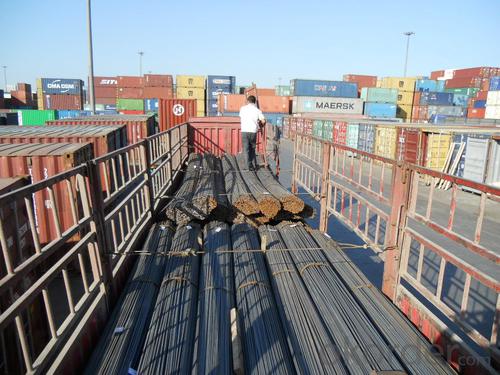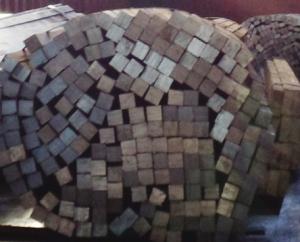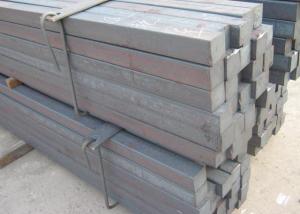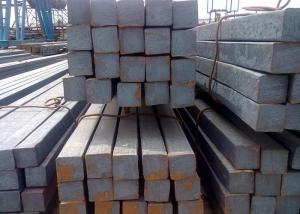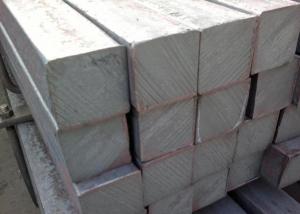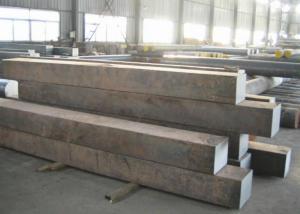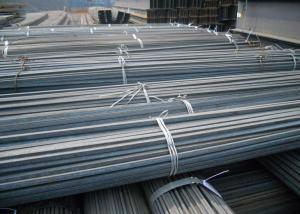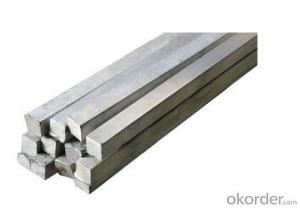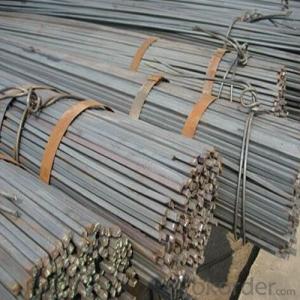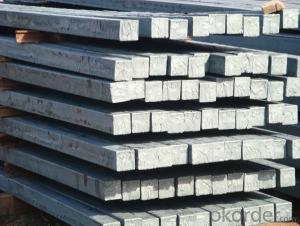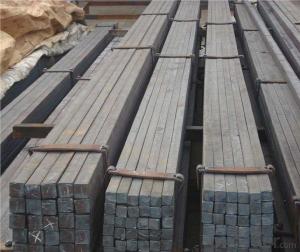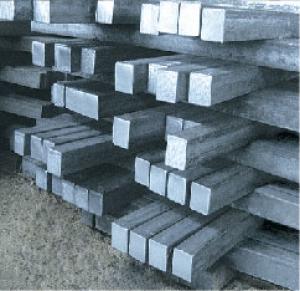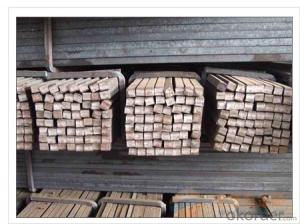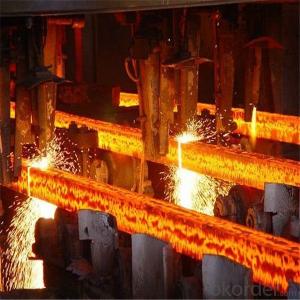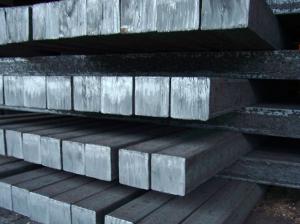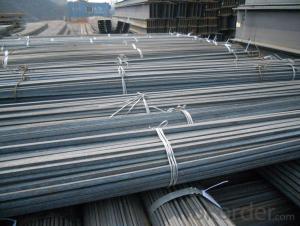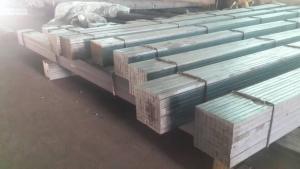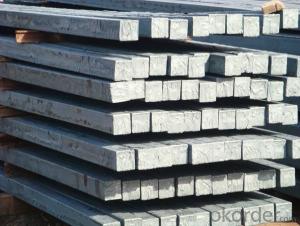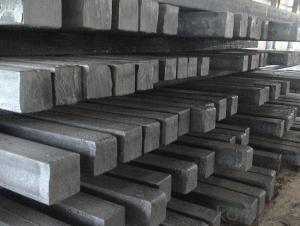square steel; square bar;billet
- Loading Port:
- Tianjin
- Payment Terms:
- TT OR LC
- Min Order Qty:
- 1000 m.t.
- Supply Capability:
- 30000 m.t./month
OKorder Service Pledge
OKorder Financial Service
You Might Also Like
Product Description:
Specifications of Square Steel:
-The Square Steel is hot rolled,
-Standard: GB,
-Grade: Q195 or equivalent.
Some details of Square Steel:
-List 1.The length of a side and the theoretical weight of Square Bar.
Length of a side(mm) | Theoretical weight(kg/m) | Length of a side(mm) | Theoretical weight(kg/m) |
6 | 0.283 | 32 | 8.04 |
7 | 0.385 | *33 | 8.55 |
8 | 0.502 | 34 | 9.07 |
9 | 0.636 | *35 | 9.62 |
10 | 0.785 | 36 | 10.17 |
11 | 0.950 | 38 | 11.24 |
12 | 1.13 | 40 | 12.56 |
13 | 1.33 | 42 | 13.85 |
14 | 1.54 | 45 | 15.90 |
15 | 1.77 | 48 | 18.09 |
16 | 2.01 | 50 | 19.63 |
17 | 2.27 | 53 | 22.05 |
18 | 2.54 | *55 | 23.6 |
19 | 2.82 | 56 | 24.61 |
20 | 3.14 | *58 | 26.4 |
21 | 3.46 | 60 | 28.26 |
22 | 3.80 | 63 | 31.16 |
*23 | 4.15 | *65 | 33.17 |
24 | 4.52 | *68 | 36.3 |
25 | 4.91 | 70 | 38.49 |
26 | 5.30 | 75 | 44.16 |
*27 | 5.72 | 80 | 50.24 |
28 | 6.15 | 85 | 56.72 |
*29 | 6.60 | 90 | 63.59 |
30 | 7.06 | 95 | 70.85 |
*31 | 7.54 | 100 | 78.50 |
Notes:
1, The theoretical weights in the list, base on the density of 7.85 g/cm3.
2, The numbers with *mean that they are not regulars or we don’t offer them.
-List 2. The allowed tolerance of Square Steel:
Length of a side(mm) | Allowed Tolerance | ||
Group1 | Group2 | Group3 | |
5.5~7 | ±0.20 | ±0.30 | ±0.40 |
7~20 | ±0.25 | ±0.35 | ±0.40 |
20~30 | ±0.30 | ±0.40 | ±0.50 |
30~50 | ±0.40 | ±0.50 | ±0.60 |
60~80 | ±0.60 | ±0.70 | ±0.80 |
80~110 | ±0.90 | ±1.0 | ±1.1 |
110~150 | ±1.2 | ±1.3 | ±1.1 |
150~190 | ―― | ―― | ±2.0 |
190~250 | ―― | ―― | ±2.5 |
Chemical Composition:
Standard | Grade | Element (%) | ||||
GB | Q195 | C | Mn | S | P | Si |
≤0.12 | ≤0.50 | ≤0.04 | ≤0.035 | ≤0.3 | ||
-Method of deoxidation: F, b, Z
Usage/Applications of Square Steel:
-The Square Steel is normally used as structure steel.
-Row material for other structure steel like steel angles, channels, I-beams, H-beams, etc…
Packaging & Delivery of Square Steel:
-Packing Detail: The products can be packed in bundles by steel wires.
-Delivery Detail: 30~45 working days after receive buyer’s T.T. or L/C.
Transportation & Marking:
-Transportation:
1, The products can be delivered by bulk vessel or by container.
2, The maximum quantity of loading of container is 25 tons.
3, The products usually are transported to the nearest port from the production place.
-Marks:
1, Color mark: there will be color marking on both ends of the bundles for the cargo delivered by bulk vessel. That makes is easily to distinguish at the destination port.
2, Tag mark: the tag marks will be tied up to each bundle. The information is usually including supplier’s logo and name, product name, made in China, products’ specifications and other information requested by customers.
Payment:
-Invoicing on theoretical weight or actual weight as customer’s request.
-Regular terms of payment:
1, 30% payment in advance, the remaining balance (70% payment) against the copy of B/L.
2, 30% payment in advance, the remaining balance (70% L/C) against the copy of B/L.
3, Negotiable.
- Q: Can a steel square be used for plumbing work?
- Plumbing work can indeed utilize a steel square. Known as a framing square or carpenter's square, this versatile tool finds its place in the construction industry, including plumbing. Although not the go-to tool for plumbers, it can prove useful in specific scenarios. A steel square enables the measurement and marking of angles, checking for squareness, and laying out straight lines. These functions prove invaluable when dealing with plumbing projects demanding precise measurements and alignments. For instance, during pipe installations, a steel square guarantees proper alignment at right angles. Furthermore, a steel square facilitates swift and accurate measurements for pipe cutting and joining. Its straight edges and measuring scales provide the accuracy required for precise cuts and connections. Nevertheless, it is essential to acknowledge that other tools designed explicitly for plumbing work may better suit certain tasks. Pipe wrenches commonly handle tightening and loosening pipes, while pipe cutters efficiently slice through them. To summarize, although not the most specialized tool for plumbing, a steel square remains effective in certain situations. It comes in handy for measuring, marking, and layout tasks, as well as providing accurate measurements for pipe cutting and joining.
- Q: How do you use a steel square to measure the height of a doorway?
- To use a steel square to measure the height of a doorway, you would simply place the square vertically against the side of the doorway, ensuring one edge of the square is flush against the floor. Then, read the measurement on the vertical side of the square to determine the height of the doorway.
- Q: How do you use a steel square to measure and mark out angled cuts?
- To use a steel square to measure and mark out angled cuts, you will need to follow a few steps: 1. First, ensure that your steel square is clean and free from any dirt or debris to ensure accurate measurements. 2. Identify the angle you need to cut. The steel square typically has two arms, a longer one known as the blade, and a shorter one called the tongue. The blade is usually marked with various angles, such as 45 degrees or 90 degrees. 3. Align the blade of the steel square with the edge of the material you are working with. This edge should be perpendicular to the blade. 4. Once the blade is aligned, extend the tongue of the steel square along the material, making sure it overlaps the edge you want to cut at the desired angle. The tongue should form a straight line with the blade. 5. Use a pencil or a sharp object to mark the edge of the material along the tongue of the steel square. This mark will indicate the angle at which you need to make the cut. 6. Double-check your measurements and marks before proceeding with the cut to ensure accuracy. It is always better to measure twice and cut once. 7. Finally, use a suitable cutting tool, such as a saw or a power tool, to make the angled cut along the marked line. Remember to always exercise caution while working with sharp tools and follow appropriate safety measures to avoid injuries.
- Q: How do you use a steel square for marking and layout tasks?
- A steel square, also known as a framing square or carpenter's square, is a versatile tool used for various marking and layout tasks in woodworking and construction. To use a steel square effectively, follow these steps: 1. Familiarize yourself with the parts: A steel square typically consists of two arms, a longer one called the blade and a shorter one called the tongue. The blade is marked with measurements and angles, while the tongue is used as a reference surface. 2. Set up your workpiece: Place the steel square on the surface of your workpiece, ensuring that it is aligned with the edges or corners you want to mark or layout. Hold it firmly in place to avoid any movement. 3. Mark straight lines: One of the primary uses of a steel square is for marking straight lines. Align the blade or tongue against the edge of your workpiece and use a pencil or marking knife to trace along the marked measurements or angles on the square. 4. Layout angles: Steel squares are also helpful for laying out angles. Simply position the square so that the desired angle aligns with the edge of your workpiece. Then, make your marks along the blade or tongue to transfer the angle accurately. 5. Check for squareness: Another function of a steel square is to check for squareness or right angles. Place the square against a corner or edge and see if it fits snugly. If there is a gap, it means your workpiece is not square, and you can make adjustments accordingly. 6. Scribe parallel lines: To mark parallel lines, position the steel square against the edge of your workpiece and make marks along the blade or tongue at the desired distance. Then, repeat the process along the marked points to create parallel lines. 7. Create miter cuts: Steel squares are useful for creating miter cuts, which are angled cuts typically used in woodworking. By aligning the desired angle on the square with the edge of your workpiece, you can mark and cut accurately. 8. Measure and transfer dimensions: The markings on the steel square allow you to measure and transfer dimensions easily. Simply align the appropriate markings with your workpiece and mark or measure accordingly. Remember to always check the accuracy of your steel square before using it for precise tasks. Ensure that it is square and free from any defects or damage that may affect the accuracy of your markings. With practice and attention to detail, a steel square can become an indispensable tool for marking and layout tasks in your woodworking or construction projects.
- Q: Can a steel square be used as a level?
- No, a steel square cannot be used as a level. While a steel square is a useful tool for measuring angles and checking the accuracy of right angles, it does not have the necessary features to determine whether a surface is level or not. A level typically consists of a long, straight body with a bubble vial filled with liquid and an air bubble. This bubble vial allows for precise measurement of both horizontal and vertical surfaces, ensuring that they are perfectly level. Therefore, if you need to determine if a surface is level, it is recommended to use a proper level tool rather than a steel square.
- Q: How do you use a steel square to determine the angle of a compound profile cut?
- In order to determine the angle of a compound profile cut, one must use a steel square and adhere to the following instructions: 1. Start by ensuring that you possess a steel square equipped with a ruler on one side and a 90-degree angle on the other. 2. Position the steel square onto the material that requires cutting, aligning the ruler edge with one side of the material. 3. Proceed to adjust the angle of the steel square to match the desired angle for the compound profile cut. This can be accomplished by sliding the ruler edge up or down the material until the desired angle is achieved. 4. Once the angle has been set, employ a pencil or marker to indicate the line where the ruler edge intersects with the material. 5. Subsequently, repeat the aforementioned process on the opposing side of the material, aligning the ruler edge with the opposite side this time. It is crucial to maintain the same angle as previously determined. 6. Once again, mark the line where the ruler edge meets the material. 7. The angle between the two marked lines accurately represents the angle of the compound profile cut. 8. To verify the precision of the angle, it is possible to utilize a protractor or an angle measuring tool to gauge the angle between the two marked lines. By diligently following these steps and employing a steel square, one can successfully ascertain the angle of a compound profile cut.
- Q: How do you use a steel square to lay out a perpendicular line?
- To lay out a perpendicular line using a steel square, you can follow these instructions: 1. Position the steel square on the desired material or surface, ensuring that one side aligns with the edge. 2. Securely hold the steel square in place to prevent any movement. 3. Make a mark along the edge of the steel square using a pencil or scribe. 4. Without shifting the steel square, rotate it 90 degrees so that the previously aligned side becomes perpendicular to the material. 5. Once again, align the same side of the steel square with the edge of the material. 6. Keep the steel square steady and mark a second line along its edge. 7. The point where these two lines intersect indicates where the perpendicular line should be drawn. 8. Utilize a straightedge or ruler to connect the intersection point with your desired length or distance, thus creating the perpendicular line. By adhering to these steps, you can accurately and efficiently employ a steel square for laying out a perpendicular line.
- Q: Can a steel square be used for checking the squareness of picture frames?
- Yes, a steel square can be used for checking the squareness of picture frames. The straight edges and right angles of the steel square can be aligned against the corners of the frame to ensure that it is perfectly square.
- Q: How do you determine if a steel square is square?
- To determine if a steel square is square, you can use a few methods. Firstly, you can visually inspect the square by placing it against a straight edge or surface and checking if all sides and angles are perfectly perpendicular. Additionally, you can use a precision measuring tool like a caliper or micrometer to measure the sides and angles of the square, ensuring they are equal and at right angles. A more accurate method involves using a surface plate or a flat reference surface to check if the square lays flat and doesn't rock or wobble. Finally, you can perform a test by drawing lines at right angles on a piece of paper or a flat surface using the steel square, and then measuring the angles formed by the lines using a protractor or angle measuring tool.
- Q: How do you use a steel square to measure and mark 84.375-degree angles?
- To use a steel square to measure and mark 84.375-degree angles, you would typically refer to the protractor scale on the square. Align one edge of the square with the reference line, and then locate the angle measurement on the protractor scale that corresponds to 84.375 degrees. Once identified, mark the desired angle on the material using a pencil or any suitable marking tool.
Send your message to us
square steel; square bar;billet
- Loading Port:
- Tianjin
- Payment Terms:
- TT OR LC
- Min Order Qty:
- 1000 m.t.
- Supply Capability:
- 30000 m.t./month
OKorder Service Pledge
OKorder Financial Service
Similar products
Hot products
Hot Searches
Related keywords



